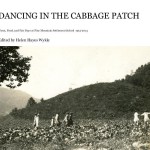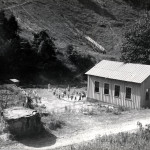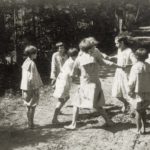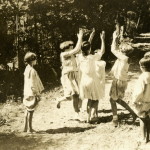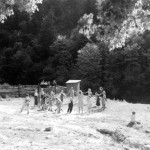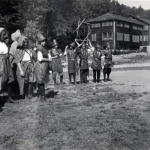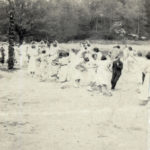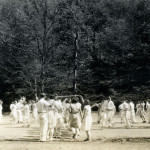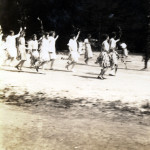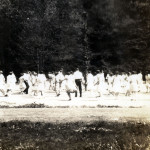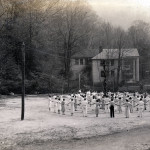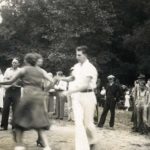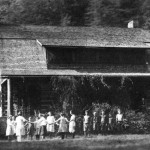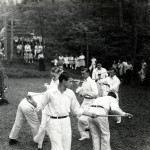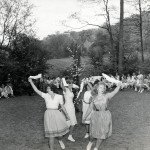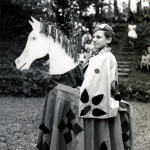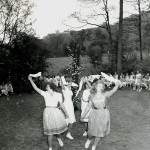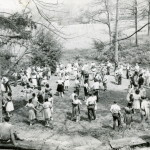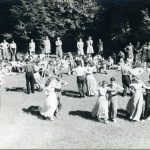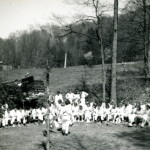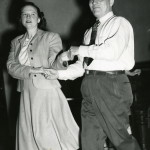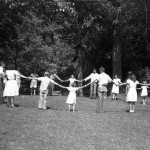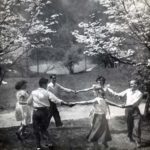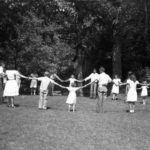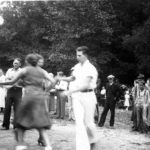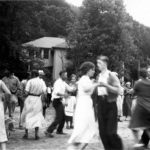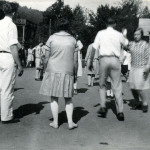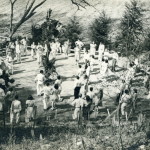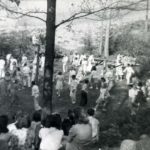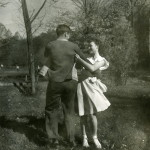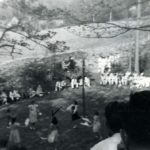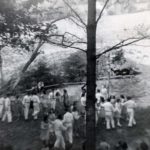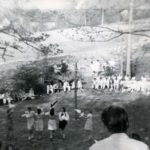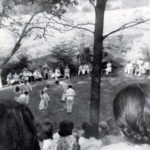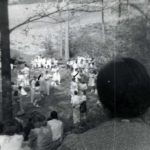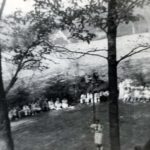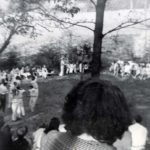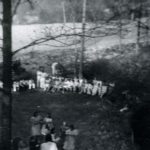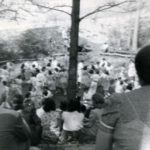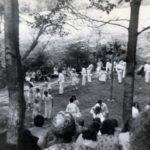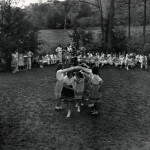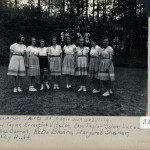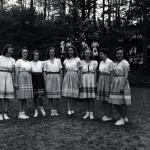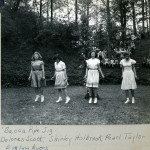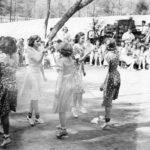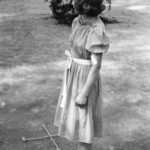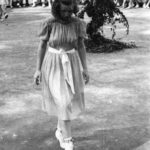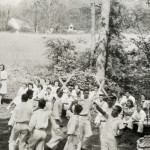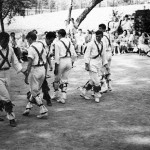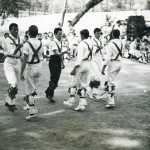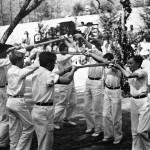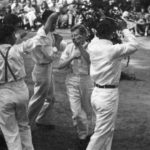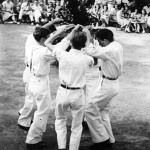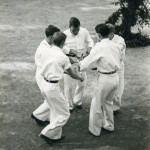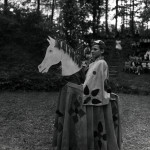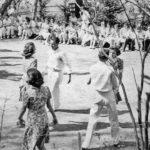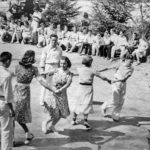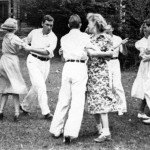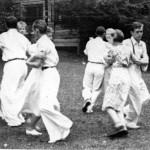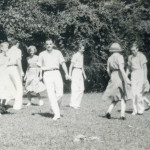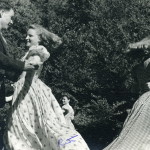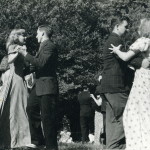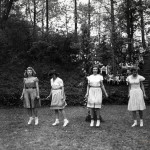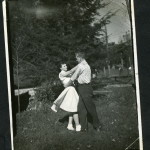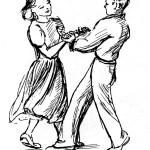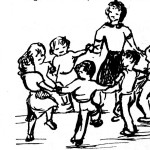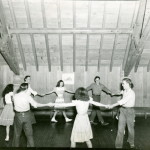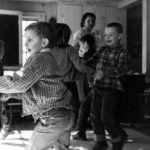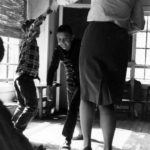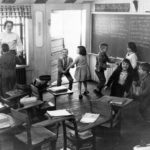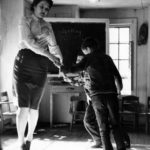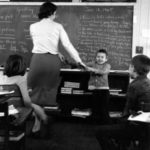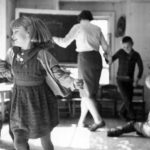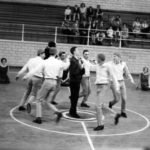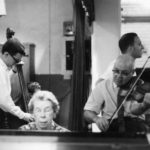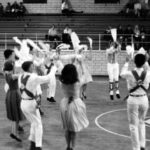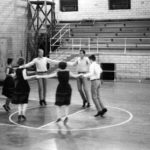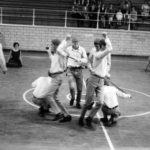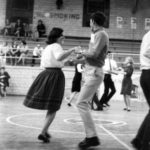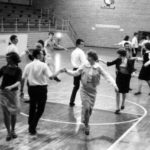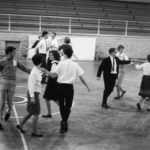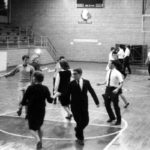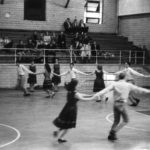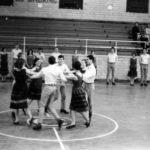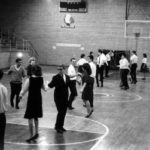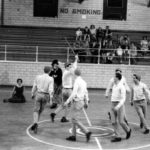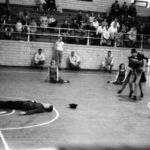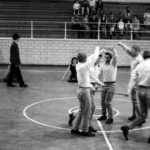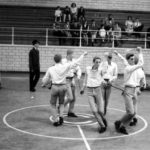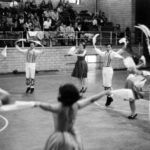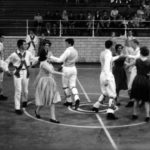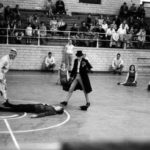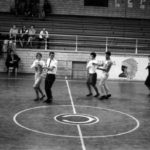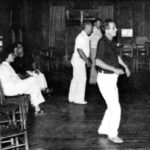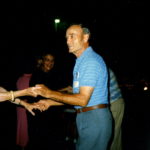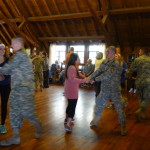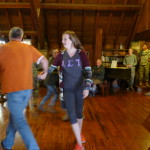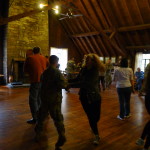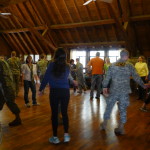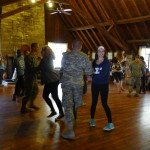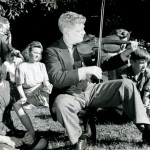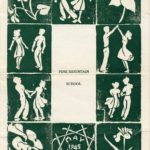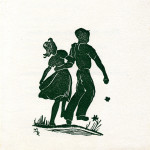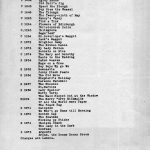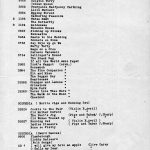Pine Mountain Settlement School
Blog: DANCING IN THE CABBAGE PATCH
TAGS: English Country Dancing, Pine Mountain Settlement School, Harlan County, Kentucky, dancing, recreation, folk dancing, set running, party games, Kentucky Running Set, Cecil Sharp, Maude Karpeles, Phil Jamison, Dorothy Bolles, Abby Winch Christensen, Dorothy Nace, Mary Rogers, Berea College Country Dancers, Berea College, Arthur Dodd, Glyn Morris,
ENGLISH COUNTRY DANCING
AT PINE MOUNTAIN SETTLEMENT SCHOOL
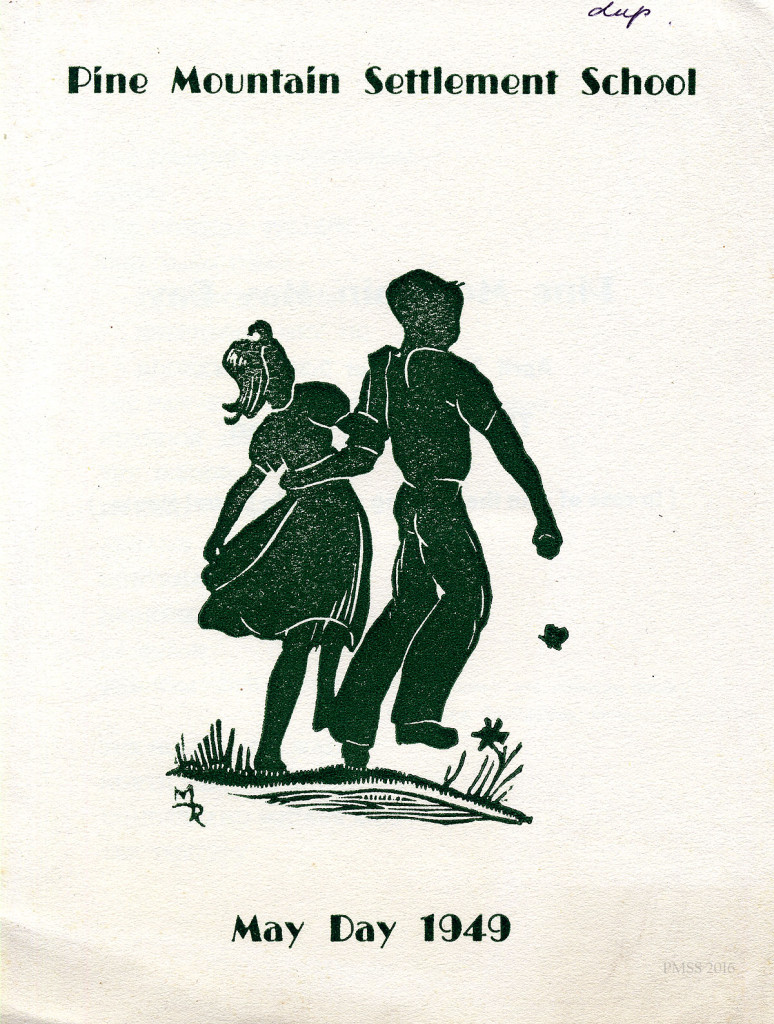
May Day 1949. Drawing by Mary Rogers
English Country Dance crept into the Pine Mountain Valley like the bright green of Spring time creeps up the North flank of the mountain — slowly. Dance in the valley was not unknown in the first decades of the twentieth century, but the gentility of English Country Dance was unknown. Anywhere there was a large community gathering in the mountains of Eastern Kentucky there were “parties” and “party games” and often “set-running.” Churches were largely opposed to “dancing” but “party games” were often accepted. In the more strict religious sects, dance had always been forbidden. Dancing was seen as the work of the devil, but so was moonshine, but never guns.
In the Pine Mountain Valley, many in the community had been “dancing” most of their lives. The dance most favored was one later called the Kentucky Running Set. It was a fast-paced, vigorous and lengthy series of maneuvers which were rhythmically called out by a leader. According to Phil Jamison, in his 2015 book, Hoedowns, Reels, and Frolics: Roots and Branches of Southern Appalachian Dance, pp.72-73, the idea of a “Running Set” is not as intuitive as it seems. A noted North Carolina dance historian, dancer and set caller, Jamison suggests that the term “set” has several definitions.
In the seventeenth century, for example, a “set” was used to describe a series of simple steps in place to one’s partner, as in the action to “set” to a partner before turning. Jamison. however, also conjectures that Karpeles and Sharp conflated the meaning with another “set”, that of a composition of figures, such as Jamison’s suggestion, “a ‘set of Quadrilles.'” Further, French dances that had many parts were referred to as “sets”. This last description of a set given by Jamison, suggests to him that the use of the term is associated with the idea of a Quadrille “set” and this seems to be confirmed in the appearance of the term and idea in the Southern Appalachians. Strengthening his argument for a French connection with the Quadrille, he quotes Karpeles from an article, “Some Additional Figures for Set Running,” In the Journal of the English Folk Dance Society 2, no. 3 (1930): 39-50.
“It is very probable that the word ‘set’ implies a ‘set of figures,’ in the way that it is customary to speak of a ‘set of Quadrilles.'”
As for “running” Jamison conjectures that it has its origins in Scotland. In dances, particularly the reel, where “running a set” was a common description of the dance pattern.
It was this “dance,” this running of sets, that surprised and charmed one of the world’s leading instructors of English Country Dance when he first viewed it at Pine Mountain. The dance form had been observed by visitors to the School and commented on by the staff when visiting on fundraising trips to the North East. And when Cecil Sharp came to America, it was recommended by English Country Dance lovers in the North East that Sharp come listen to the ballad singers and see what the remote people in Eastern Kentucky had retained of old English forms of entertainment in song and dance. Pine Mountain gave Cecil Sharp a gift, and Cecil Sharp left a gift for the School — English Country Dancing.
Cecil Sharp‘s discoveries at the School were well described in his book. English folk songs from the southern Appalachians, collected by Cecil J. Sharp; comprising two hundred and seventy-four songs and ballads with nine hundred and sixty-eight tunes, including thirty-nine tunes contributed by Olive Dame Campbell, edited by Maud Karpeles. Oxford: Oxford University Press, 1932. The book, dedicated to William Creech, the donor of the land for the Pine Mountain Settlement School remains a testimony of a mutual fondness for the culture of the Southern Appalachians. When Cecil Sharp came to the School along with his secretary, Maud Karpeles, he witnessed a joyful and energetic community of set runners and when he left, he set a tradition for the inclusion of English Country Dancing in annual celebrations and in the school’s educational program.
GALLERY I: DANCING IN THE CABBAGE PATCH English Country Dancing at PMSS
- Dancing in the Cabbage Patch
- Big Laurel school and circle dance. Arthur W. Dodd Album. [dodd_A_042_mod.jpg]
- Angela Melville Album II – Part VI. Folk dancing. [melv_ii_album_320x_alt]
- “Gathering Peascods,” c. 1920s
- Big Laurel School; dancing on the playground. VI-51 – 1625.
- Maya Sudo Album: “Sword Dancers; Boy’s House”. 016
- May Day dancing on the Playground. cobb_alice_051
- “May Day.” dancing [kingman_074a]
- “May Day.” Kentucky Running Set ? [kingman_088c]
- “May Day.” Kentucky Running Set? [kingman_088d]
- “May Day.” Circle dance on playground. [kingman_088a.jpg]
- “Set running.” Ben Turner (in white; far right, Glyn Morris; seated, Miss Dorothy Bolles and Miss Evelyn Wells. Kentucky Running Set, 1934. [boarding_school_767a.jpg]
- Big Log. Front facade with children dancing. [II_08_big_log_329d.jpg]
- 1945 May Day on the Dancing Green with Morris dancers. Arthur W. Dodd Album. [dodd_A_053_mod.jpg]
- 1945 May Day on the Dancing Green. Students and “Handkerchief Dance.” Arthur W. Dodd Album. [dodd_A_051_mod.jpg]
- The Hobby Horse – Eli Ison, May 1946, Morris Dance] [nace_1_021c.jpg]
- “Glorishears” Morris Dance — 1946. Shirley Holbrook and Delores Scott in lead. [nace_1_021a.jpg]
- Joe Bramlett Album – Dancing on the May Day Green. [bram_-49.jpg]
- Dancing Green. View of dancers. at May Day, c. 1940s. [II_11-02_dancing_green_0373a-2.jpg]
- Dancing Green. Gathering for May Day. [II_11-02_dancing_green_0373b.jpg]
- Louise Fliermans, Home Economics teacher dancing with Weaver Smith of Harlan at a dance at the Country Club, 1948.
- Lutrella Baker Album. Line Fork Settlement, 1937-41. Circle dance with community at Cabin lawn. [line_fork_005c.jpg]
- “May Day 1948.” Boys and girls dancing in circle. [nace_II_album_036.jpg]
- Line Fork community, dancing during the Baker years, early 1940s. [line_fork_005c-1.jpg]
- 1933 Fair Day. Dancing on the Playground near Burkham School House II. [III_campus_life_0767a]
- 1933 Fair Day. Dancing on the Playground near Burkham School House II. [III_campus_life_078]
- “May Day.” Set-running ? [kingman_088b]
- 1940s Dancing Green. Dancing during May Day, c. 1940s. [II_11-02_dancing_green_0374.jpg]
- “May Day 1948.” Boys and girls dancing in circle. [nace_II_album_036.jpg]
- May Day on the Dancing Green, 1941. [bishop_05_006.jpg]
- Joe Bramlett Album – Dancing on the green: (?) and Bonnie Faye Reynolds (?). (Photo by Arthur Dodd) [bram_-43.jpg]
- May Day on the Dancing Green, 1941. [bishop_05_005.jpg]
- May Day on the Dancing Green, 1941. [bishop_05_004.jpg]
- May Day on the Dancing Green, 1941. [bishop_05_003.jpg]
- May Day on the Dancing Green, 1941. [bishop_05_002.jpg]
- May Day on the Dancing Green, 1941. [bishop_05_001.jpg]
- “Shepherd’s Hay Jig – James Centers.” May Day on the Dancing Green, 1941. [bishop_04_005.jpg]
- May Day on the Dancing Green, 1941. [bishop_04_004.jpg]
- May Day on the Dancing Green, 1941. [bishop_04_003.jpg]
- May Day on the Dancing Green, 1941. [bishop_04_002.jpg]
- May Day on the Dancing Green, 1941. [bishop_04_001.jpg]
- 1945 May Day on the Dancing Green. Arthur W. Dodd Album.[dodd_A_052_mod.jpg]
- 1945 May Day on the Dancing Green. Arthur W. Dodd Album. [dodd_A_054_mod.jpg]
- 1945 May Day on the Dancing Green. Arthur W. Dodd Album. [dodd_A_054_mod.jpg]
- 1945 May Day on the Dancing Green. Arthur W. Dodd Album. [dodd_A_055.jpg]
- May Day celebration. c. 1944. [dodd_A_052_mod]
- Dancing on the Dancing Green, late 1930s. [burkh_007.jpg]
- Baca Pipes dance on the Dancing Green, late 1930s.[burkh_006.jpg]
- Baca Pipes dance on the Dancing Green, late 1930s.[burkh_005.jpg]
- Sword team, 1945. [nace_1_021b.jpg]
- Morris Dancing at PMSS. [III_campus_life_0777c.jpg]
- Dieter Album – English Morris dancing. [shul_015.jpg]
- Morris Dancing at PMSS. [III_campus_life_0783.jpg]
- Sword dancing on the Dancing Green, late1930s. William Hayes (back to camera, rt.) Glyn Morris, Paul Hayes, ?.? [burkh_004.jpg]
- Sword Dancing, the forming of the star. [III_campus_life_0779a.jpg]
- May Day celebration. 1945. [dodd_A_053_mod]
- Dieter Album – Sword dancers. William Hayes, facing camera. [shul_016.jpg]
- 1945 May Day. Hobby Horse and Morris dancing on the Dancing Green. Arthur W. Dodd Album. [dodd_A_050_mod.jpg]
- Folk dancing on the Dancing Green, late 1930s.[burkh_003.jpg]
- Folk dancing on the Dancing Green, late 1930s. [burkh_002.jpg]
- William and Fern Hall Hayes, dancing. [III_campus_life_0775.jpg]
- Folk dancing at Pine Mountain. [III_campus_life_0774.jpg]
- Dieter Album – Dancing on the Green. Paul Hayes facing camera. In background, Fern Hall Hayes, Joan Ayers.[shul_001.jpg]
- Dieter Album – Ruth Shuler and partner to far left. [shul_020.jpg]
- Dieter Album – Dancing on the Green. Ruth Shuler to far right. [shul_017.jpg]
- 1945 May Day on the Dancing Green. Arthur W. Dodd Album. [dodd_A_055_mod.jpg]
- Dancing. Grace Rood Album.
- Mary Rogers, drawing. Dancing. II.
- Mary Rogers, drawing. Dancing I
- Folk dancing in Laurel House II. Grace Rood Album.
- 1810c Four students dancing with Mrs. Whitaker. [ 58_Life and Work_Children and Classes_029]
- 1810 Mrs. Whitaker and two student boys dancing. [58_Life and Work_Children and Classes_026]
- 1811a Mrs. Whitaker and 7 students dancing. [58_Life and Work_Children and Classes_031]
- 1811 Mrs. Whitaker and two students dancing. [58_Life and Work_Children and Classes_030]
- 1810b Mrs. Whitaker and two students dancing with girl and boy watching. [58_Life and Work_Children and Classes_028]
- 1810a Sally Boggs, Mrs. Whitaker, and students dancing. [58_Life-and-Work_Children-and- Classes_027.jpg]
- “Cumberland Swapping Meeting and Berea [Dancers.” 48_f&neigh_gather_1532.jpg]
- “Cumberland Swapping Meeting and Berea Dancers.” 48_f&neigh_gather_1528
- “Cumberland Swapping Meeting and Berea Dancers.” 48_f&neigh_gather_1530a
- “Cumberland Swapping Meeting and Berea Dancers.” 48_f&neigh_gather_1527b
- “Cumberland Swapping Meeting and Berea Dancers.” 48_f&neigh_gather_1526
- “Cumberland Swapping Meeting and Berea Dancers.” [48_f&neigh_gather_1523.jpg]
- “Cumberland Swapping Meeting and Berea Dancers.” 48_f&neigh_gather_1522
- “Cumberland Swapping Meeting and Berea Dancers.” Berea College Country Dancers. 48_f&neigh_gather_1522a
- “Cumberland Swapping Meeting and Berea Dancers.” Berea College Country Dancers. 48_f&neigh_gather_1521a
- “Cumberland Swapping Meeting and Berea Dancers.” 48_f&neigh_gather”Cumberland Swapping Meeting and Berea Dancers.” Berea College Country Dancers. _1521
- “Cumberland Swapping Meeting and Berea Dancers.” Berea College Country Dancers. 48_f&neigh_gather_1520c
- “Cumberland Swapping Meeting and Berea Dancers.” Berea College Country Dancers. 48_f&neigh_gather_1520
- “Cumberland Swapping Meeting and Berea Dancers.” Berea College Country Dancers. 48_f&neigh_gather_1520a
- “Cumberland Swapping Meeting and Berea Dancers.” Berea College Country Dancers. 48_f&neigh_gather_1520b
- “Cumberland Swapping Meeting and Berea Dancers.” [48_f&neigh_gather_1523a.jpg]
- “Cumberland Swapping Meeting and Berea Dancers.” 48_f&neigh_gather_1532a
- “Cumberland Swapping Meeting and Berea Dancers.” 48_f&neigh_gather_1531a
- “Cumberland Swapping Meeting and Berea Dancers.” 48_f&neigh_gather_1531
- “Cumberland Swapping Meeting and Berea Dancers.” 48_f&neigh_gather_1530
- “Cumberland Swapping Meeting and Berea Dancers.” 48_f&neigh_gather_1529
- “Cumberland Swapping Meeting and Berea Dancers.” 48_f&neigh_gather_1525
- “Cumberland Swapping Meeting and Berea Dancers.” 48_f&neigh_gather_1524
- 1981 Homecoming Minutes, “Dancing Party at Laurel House — ‘Black Nag.'” [1981_pmss_alum_min_007.jpg]
- 1980’s Alumni Dancing in Laurel House. Fern Hayes and William Hayes. dancing at Pine Mountain.
- 2015 Community and James Madison University get a chance to participate in a community day event. Dancing with the gentlemen from Harlan’s Challenge Academy. [P1060835.jpg]
- 2015 Community and James Madison University get a chance to participate in a community day event. Dancing with community members. [P1060849.jpg]
- 2015 James Madison University gets a chance to participate in a community day event. Dancing and dancing some more. [P1060858.jpg]
- 2015 James Madison University gets a chance to participate in a community day event. Dancing with the gentlemen from Harlan’s Challenge Academy. [P1060827.jpg]
- 2015 James Madison University gets a chance to participate in a community day event. Dancing with the gentlemen from Harlan’s Challenge Academy. [P1060828.jpg]
- Glyn Morris playing fiddle. X_100_workers_2614_mod.jpg (dup)
- May Day 1945 Program. [bishop_04_009.jpg]
- 01 May Day 1949 program (black & white image). Cover illustration by Mary Rogers. [may_day_1949_001]
Some English Country Dancers may recognize formations that readily suggest the named dance being performed. Most will not. Many times the dance forms overlap and are incorporated in a new dance with new sequences and new rhythms. Few English Country Dancers, will, however, fail to recognize the familiar names of the dances.
RECORDINGS: COUNTRY DANCE MUSIC LIST RECOMMENDED BY DOROTHY BOLLES
When Pine Mountain Settlement School was organizing its dance programs they borrowed heavily from the Boston Center music and dances. Dorothy Bolles, the link in that important chain of influence, supplied the School with a list of available music for English Country dancing.
Here is her list of “His Master’s Voice, Gramophone Records” most of which were collected by Pine Mountain or were played on the piano by Arthur Dodd and accompanied by Glyn Morris on violin or by fiddlers in the community.
- bolles_d_corr_047
- bolles_d_corr_047a
All records are 12″ and 4/6
| I.D # | Titles |
| C 1644 | Apley House Old Noll’s Jig |
| C 1645 | Seed the Plough Pop Goes the Weasel |
| C 1646 | The Triumph The Twenty-ninth of May |
| C1263 | Nancy’s Fancy Tink a Tink |
| C1264 | Flowers of Edinburgh Christchurch Bells |
| C 1265 | Childgrove Sage Leaf |
| C 1266 | Mr. Beaveridge’s Maggot Jack’s Maggot |
| C 1072 | Brighton Camp The Ribbon Dance |
| C1073 | My Lady Cullen Bonnets So Blue |
| C 1074 | The Mary and Dorothy Haste to the Wedding |
| B 2954 | Oaken Leaves Mage on a Cree Hey Boys Up Go We |
| B 2955 | Newcastle Jenny Pluck Pears |
| B 2956 | The Old Mole Shepherd’s HOliday Parson’s Farewell |
| B 2957 | The Phoenix St. Martins |
| B 2958 | Lady Speller Rufty Tufty The Maid Peeped Out at the Window |
| B 2959 | The Merry Merry Milkmaids If All the World Were Paper The Black Nag |
| B 5071 | Galopede We Won’t Go Home Till Morning |
| B 1370 | Scotch Cap The Boatman Picking Up Sticks |
| B 1371 | Chelsea Reach The Lady in the Dark Confess |
| B 1372 | Argeers Broom, the Bonny Bonny Broom Oranges and Lemons |
| 9769 | Helston Furry Indian Queen |
| 5503 | Fourpence Halfpenny Farthing Lilli Burlero |
| 5504 | Epping Forest Gathering Peascods |
| B 1193 | Three Mewt The Butterfly |
| B 1194 | Goddesses Hudson House |
| 5505 | Picking Up Sticks Newcastle |
| 5434 | Haste to the Wedding Bonnets So Blue |
| 5733 | Hey Boys Up Go We Rufty Tufty Mage on a Cree Parsons Farewell |
| 5734 | Sellinger’s Round The Black Nag If All the World Were Paper |
| DB 82 | Dick’s Maggot (orch.) Nonesuch |
| DB 84 | The Fine Companion Hit and Miss The Beggar Boy Heartsease |
| DB 182 | Oranges and Lemons Grimstock Hyde Park |
| DB 183 | Never Love Thee More The Maid in the Moon Chestnut |
| COLUMBIA (Morris Jigs and Running Set) | |
| DB 226 | Jackie to the Fair (Violin E. Avril) Old Mother Oxford (Violin E. Avril) The Fool’s Jig (Pipe and Tabor/ J. Sharp) Old Woman Tossed Up (Pipe and Tabor/ J. Sharp) |
| DB227 | Running Set (Violin E. Avril) Ladies Pleasure (Pipe and Tabor/ J. Sharp) None So Pretty |
| COLUMBIA (Sword Dances) | |
| 9800 | Flamborough Kirkby Malzeard (Folk Songs) |
| DB ? | I Will Give My Love An Apple (Clive Carey) Oh Sally My Dear (Clive Carey) My Billy Boy (Clive Carey) The Lover’s Tasks (Clive Carey) |
| DB 336 | A Farmer’s Son So Sweet (Annete Blackwell) As I Sat On A Sunny Bank (Annete Blackwell) Dance to Your Daddy (Annete Blackwell) |
SEE:
DANCING IN THE CABBAGE PATCH English Country Dancing at Pine Mountain Settlement School
CECIL SHARP AND MAUD KARPELES VISIT TO PMSS

